Table of contents
1. Transparent data collection vs. Google, Facebook and Co.
2. From psychological research to smartphone addiction to business insights for market researchers
3. Case study: Measurement of advertising on Facebook—your own and that of your competition
4. Case study: Looking into influencers’ stories on instagram
5. Case study: Reconstruction of the complete customer journey in the Amazon app
6. Data privacy and transparent, fair tracking
1. Transparent data collection vs. Google, Facebook and Co.
Because of long-lasting oligopolies, Big Tech companies have impossible to match data advantages over all other players who are not Google, Facebook, Apple or Amazon. It’s not for nothing that Apple has created its own term for making a successful app obsolete by copying it and integrating it directly into the operating system. So-called “sherlocking” was coined when Apple simply integrated the search function of the third-party app “Watson” into its new, proprietary, search app “Spotlight”.
While there have been opportunities to research users’ digital behavioral data in the more open world of laptops and desktops already for a long time, mainly IT giants have benefited so far from usage insights into closed smartphone operating systems. And yet cell phone data depicts the behavior of its users through its diverse apps (telephone, social media, shopping apps, etc.) and sensors (e.g. GPS, pedometer, sleep tracking, etc.) much better than any other individual data source. The mobile phone is our constant companion in everyday life and, specifically for Facebook, Instagram and YouTube, it is used on average for 60 minutes a day.
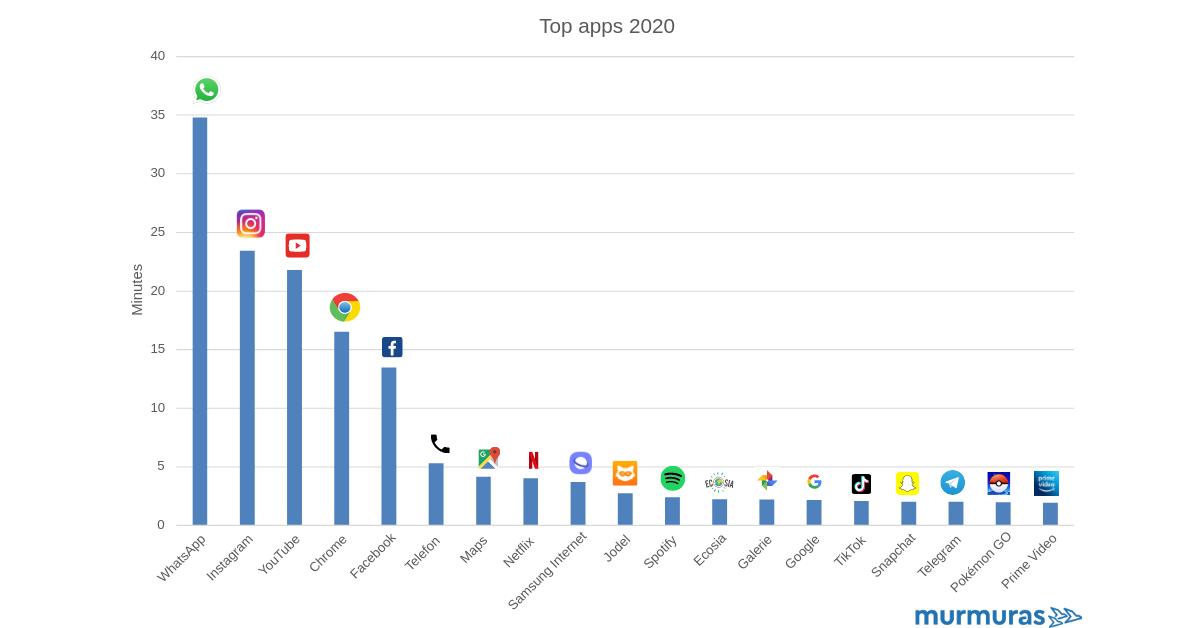
Most used smartphone apps in Germany in 2020 (Source: Statista).
So it is no wonder that the digital top dogs dominate the playing field with their big data methods. One of Steve Job’s favorite quotes was: “Good artists copy, great artists steal.” And it is well-known that he stole this saying from Picasso. To have a chance in the digital world, we have to turn the tables and beat the big guys at their own game—by collecting and analyzing digital behavioral data from smartphones ourselves.
2. From psychological research to smartphone addiction to business insights for market researchers
This is exactly what a research team at the University of Bonn has been working on since 2014. The co-founders of Murmuras, with Prof. Alexander Markowetz, used real smartphone data for the first large-scale study on smartphone addiction.
The resulting “Menthal” app records smartphone usage for study purposes, calculates in-depth analyzes and gives users feedback on their behavior. Menthal had already hit a nerve with this in 2014: From morning shows on TV to Deutsche Welle, the app has received a lot of press attention and has attracted more than 700,000 participants to date. Menthal represents the largest human behavioral data set available to academic research and collected through academic endeavors. This data set is intended exclusively for academic purposes and is kept at the University of Bonn.
Over time, numerous researchers and market research companies have asked whether they can use the Menthal technology for their own projects. That is why we founded Murmuras, which allows market researchers and academic institutions to collect and analyze smartphone usage data. Whether it’s a sleep study or shopper insights, we are convinced that data scientists of all stripes should have the same broad access to smartphone behavioral data as Google, Facebook and Co.
Using the Murmuras app and platform, in-depth analyzes with thousands of real data points per user can be carried out. Hundreds of test participants can be connected without higher marginal costs. Both the digital activities on the mobile phone (e.g. which app people use to search/buy products) and the physical activities in the real world (e.g. which shops people go to) can be recorded and analyzed in combination.
Industry-specific insights are diverse: from reading behavior (which social media posts users “like”) to mobility behavior (does the person call a taxi when it rains instead of renting a bike?) to sports (does the person train at home with home training apps or outdoors with jogging and hiking apps?) and travel preferences (convenient Couchsurfing and Airbnb, or expensive hotel websites?). By means of context-sensitive questions posed via push notifications at a specific point in time, it is possible to combine objective behavioral data with subjective statements on the test participants’ motivations and intentions (e.g. “You have just left a café, how much did you spend?”).
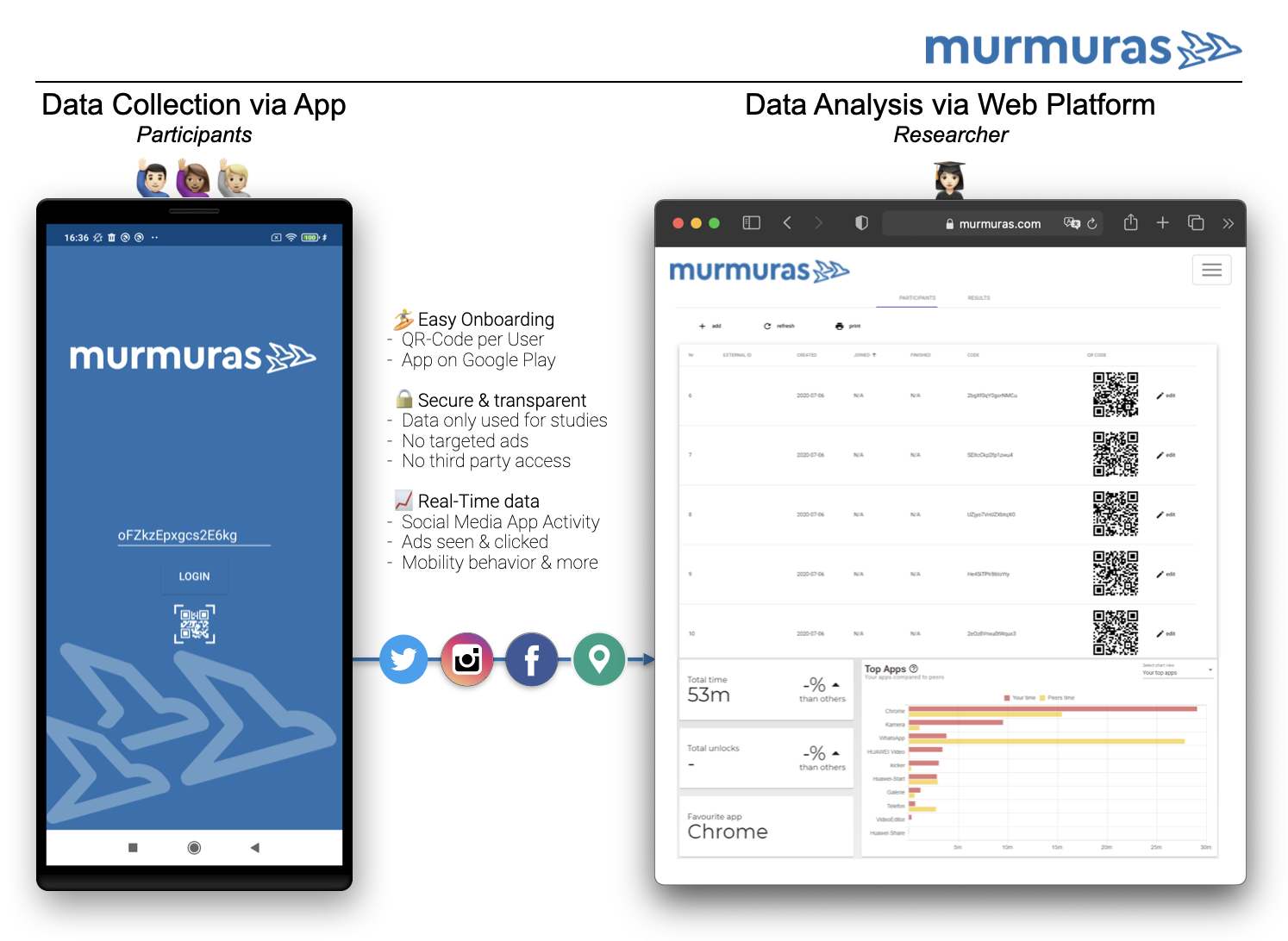
Murmuras app and platform (Source: Murmuras).
3. Case study: Measurement of advertising on Facebook—your own and that of your competition
We all know this moment: You’ve just talked with your life partner, while cooking dinner about how to convert the battered Ikea Kallax rack into a hanging indoor herb garden with the latest Ikea hacks. Less than half an hour later, the Facebook app is suddenly full of Ikea ads. A friend even changed her gender to male on Facebook to escape the constant advertising of fertility pills. While bad ad targeting can be scary or intrusive, good ad targeting is unobtrusive. To do this, however, it is necessary to ensure that it reaches the right target groups.
Facebook’s own analytics tools normally fill up the range and interaction measurement bars when it comes to paid advertising. However, the click-throughs to the advertised website are meager in comparison. While desktop browser advertising effectiveness research can still be measured quite well using classic market research methods, the Facebook app on the smartphone is a black box in this regard.
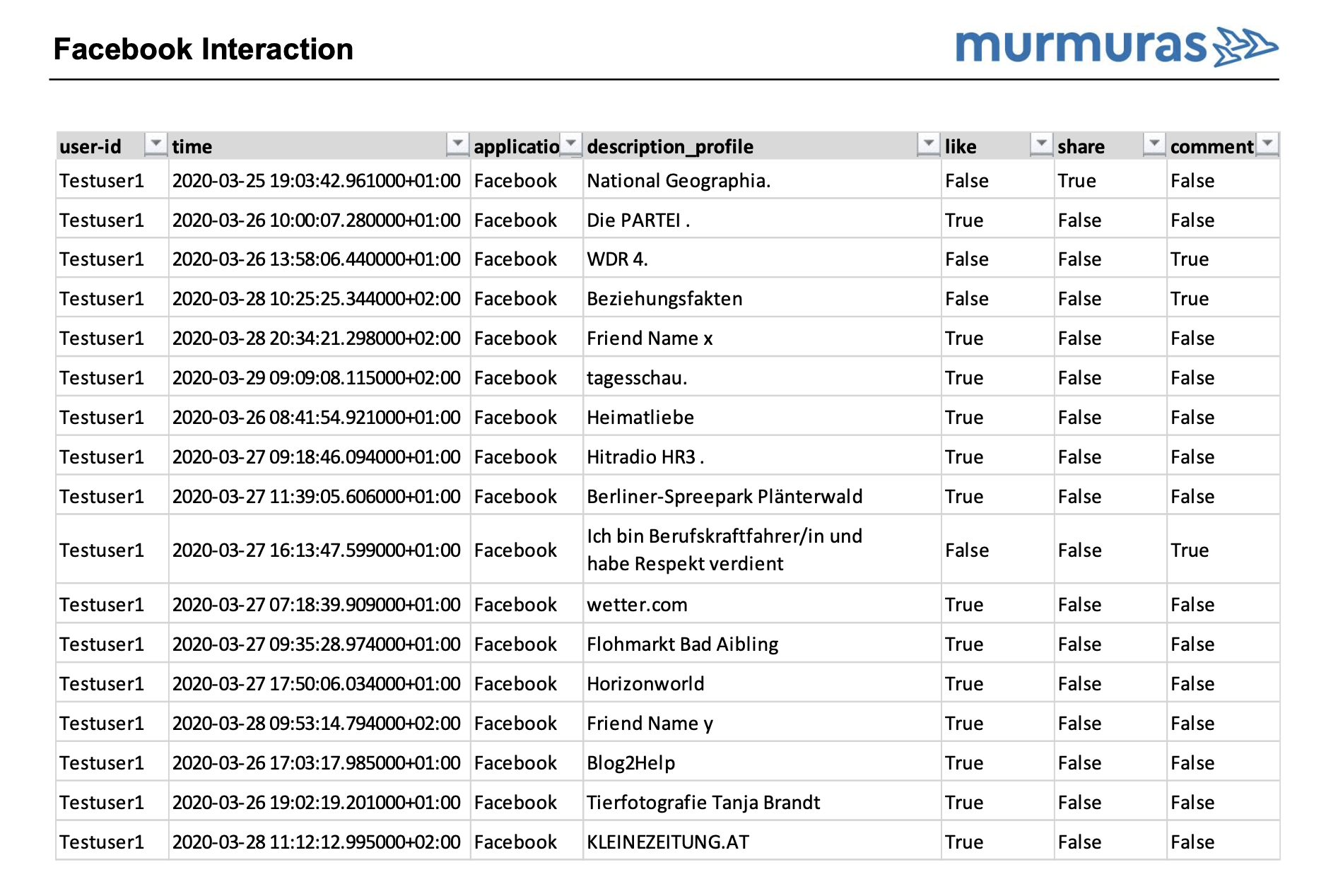
Facebook interaction sample data.
And this is exactly where we butt in: Murmuras is able to look inside the Facebook app and log precisely when a tester has seen, clicked or shared an ad. This objective, digital behavioral data, is enriched in a standardized manner by Murmuras, in cooperation with panel providers such as TestingTime, with the sociodemographic data of the test participants (age, gender, profession, occupation, etc.), so as to provide researchers with a solid data basis. Depending on legal data privacy requirements, we can also collect anonymous raw data for ourselves, which is then enriched by the market researchers themselves.
With the help of this independently recorded interaction data, we also record the ad performance in the “walled gardens” of smartphone and app ecosystems and make it possible for market researchers to check independently whether the advertising is really reaching the intended target groups.
Significant competitive advantages can be created through direct comparisons with the competition. What are the ads displayed by my competitors? Who are they targeting, with what and how often? Which ads from my competition are more successful than my own ads (measured in real terms, based on the ads viewed, clicked, shared)? How should I design my perfect ad (e.g. are emojis effective for the competitors or rather shorter texts with more focus on images)?
In the past, Adi Dassler was able to see with his own eyes how successfully the competition worked by watching the number of delivery vans that left his brother Rudolf’s company premises, because both Adidas and Puma had their headquarters in the Franconian provincial town of Herzogenaurach. Nowadays, nobody has to set a foot on their doorstep leaving their home office anymore, because our digital in-app usage data allows precise comparisons of their own campaigns with the ads of the competitors.
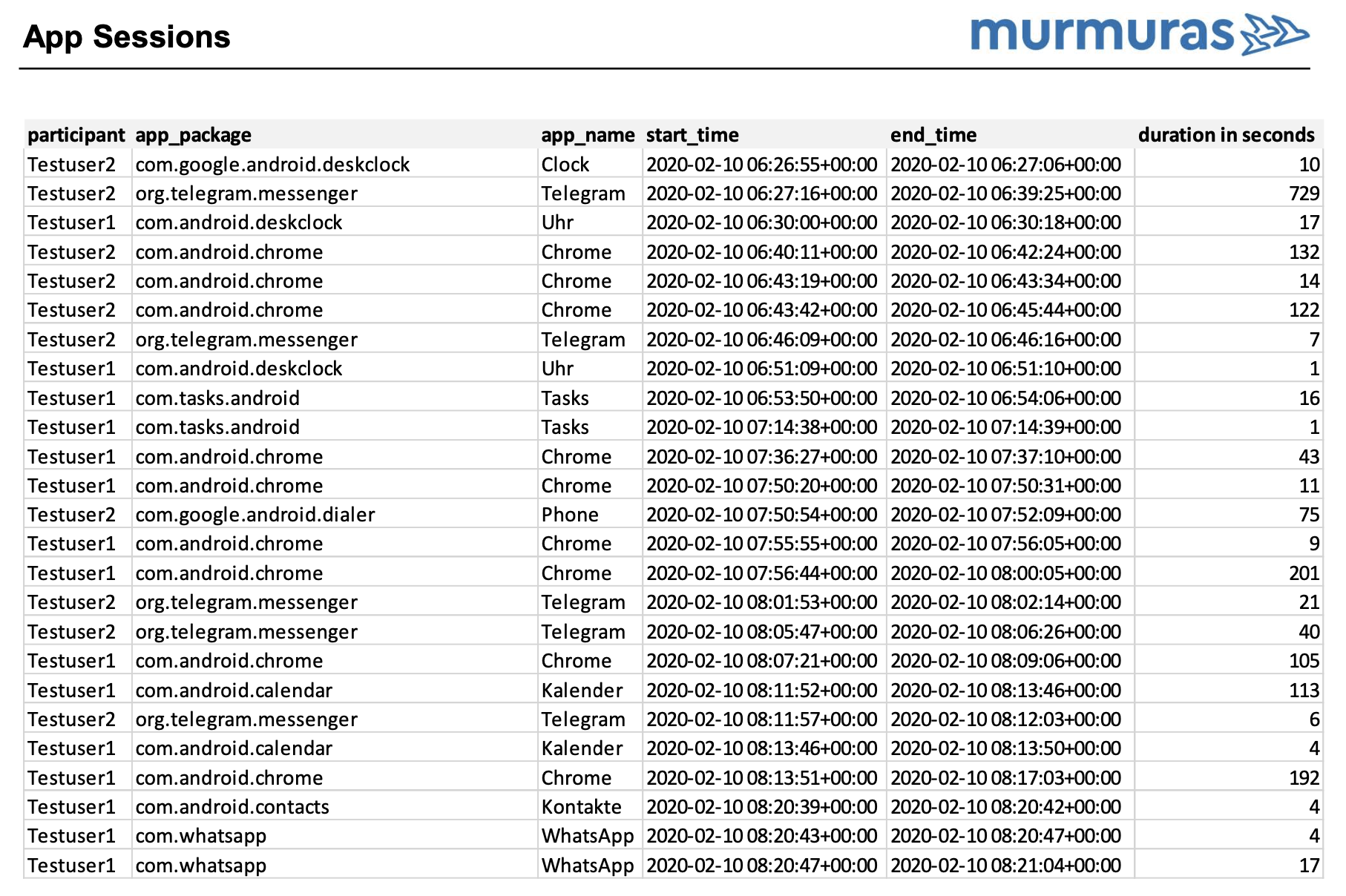
Unaggregated raw data from app sessions are an invitation to play.
Resourceful consumer researchers can follow the segmentation even further: Since Murmuras also records which apps besides Facebook are used when, for how long and in which sequence, potential sneaker customers can, for example, be classified as casual shoe buyers (no running or fitness app on their mobile phones) and sports shoe buyers (running and fitness app on their device and in use). Market research potential is opening up, especially in the high-frequency purchasing categories of fitness and food, thanks to the increased use of apps to record training and food ingestion. Which leads us straight to Facebook’s younger sister network: Instagram.
4. Case study: Looking into influencers’ stories on instagram
It is no longer a secret that influencer marketing works. From big, global mega influencers like Kylie Jenner, who market their own cosmetics collections, to local micro-influencers, who praise the hand-roasted fair trade coffee of the local castle’s café, they all have one thing in common: their business takes place on Instagram. While Facebook’s start was on desktop PCs and is still today widely used on these, Instagram has been primarily used as a smartphone app from the moment it was launched. The reasons for this are obvious: desktop PCs have no integrated photo cameras and are also very limited in their suitability for taking selfies—but this means that once again we are dealing with a closed app ecosystem that is difficult for market researchers to measure in detail.

Fitness influencer Duckfit360 advertises sportswear and protein buckets.
True to the maxim “Where there’s an advertising budget, there’s also a way”, influencers have found channels to monetize their followers. Typically, influencers upload a picture or video of themselves with the advertised product, whether in the story or as a post, and call on their followers to order it via the manufacturer’s online shop. The manufacturer assigns specific discount codes to the influencers to be able to credit to them the purchases made by their followers (see the screenshot above: “Nutze den Code #duckfit2021 um 20% Rabatt auf Sportbekleidung und Eiweißeimer zu bekommen.”; in English: Use the code #duckfit2021 to obtain 20% discount on sports clothing and protein buckets). And this is a Win-Win-Win situation for everybody: sales for the manufacturer, advertising fee for the influencer and discount for the follower.
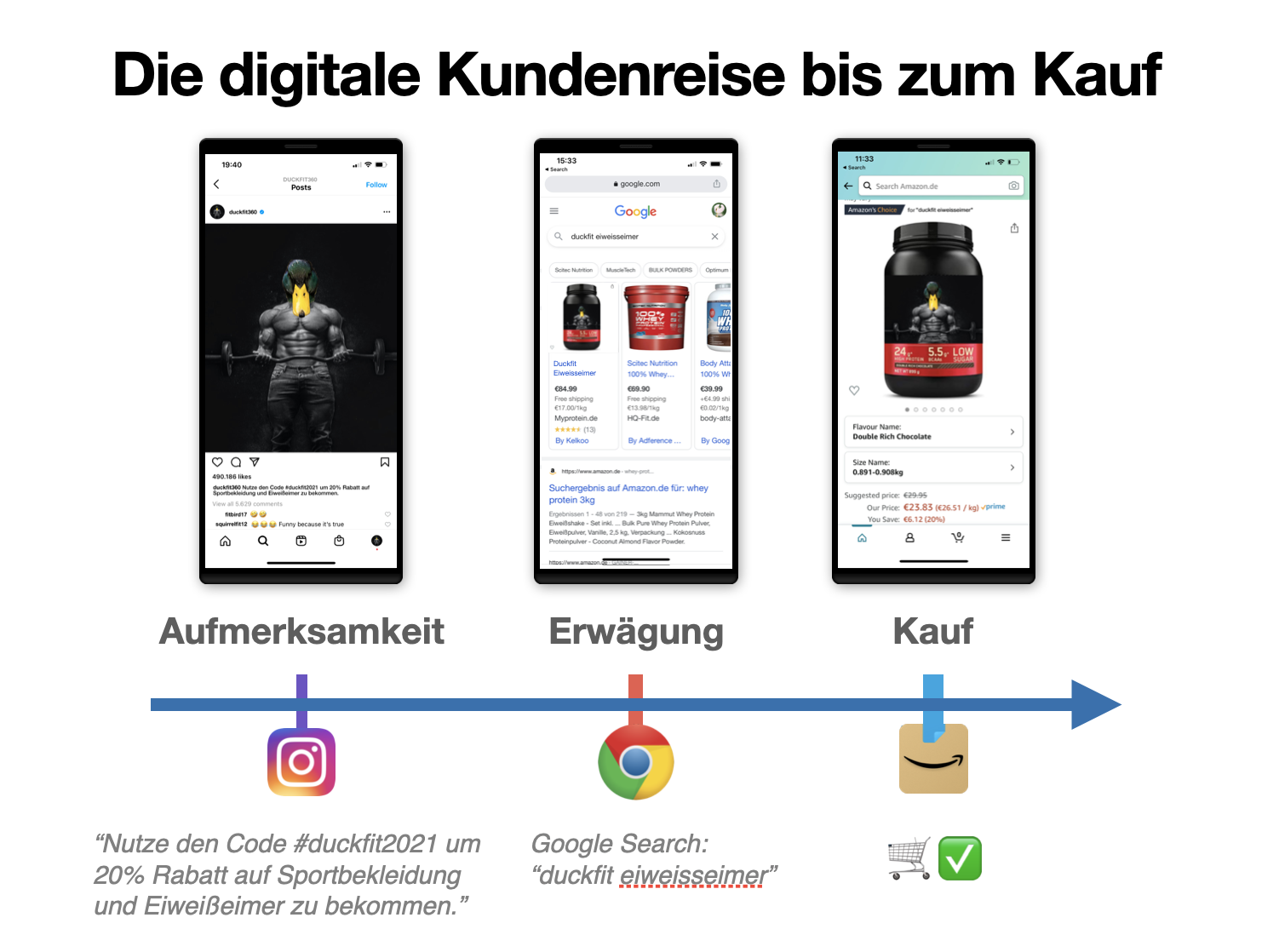
The digital customer journey up to the purchase.
Such sales tracking is downright archaic for current digital standards, and Instagram is also regularly improving it. With our digital in-app behavioral data, Murmura’s technology can be used to precisely measure how much time the followers really spend on the posts and stories of various influencers. We record views, likes and clicks for every post that the users see. With the help of app sessions, we make it visible when followers switch over to the browser after seeing an ad in a story or post and google the product, which allows us to place them at the beginning of the customer journey—an actionable insight for brands for which no cookie tracking can deliver.

Simplified raw data representation of the digital customer journey.
Generally speaking, cookie tracking is facing difficult times due to the new anti-cookie measures. In this respect, our technology is more future-proof and allows consumer researchers to position themselves redundantly, as we are not affected by cookie blockers nor social media rate limits/bans.
If requested, we can also pre-cluster Instagram behavioral data for consumer researchers, classifying the followers into consumer categories (fitness, beauty, car, etc.) based on their profiles, and thus make measurable the product-category relevant outreach of the respective influencer.
5. Case study: Reconstruction of the complete customer journey in the Amazon app
On the Online-Pitch of marktforschung.de, L’Oreal’s Director of Consumer & Market Intelligence, Sabine Menzel, reflects that the tracing of in-app touch points still is a pain point for consumer researchers.
Murmuras is able to analyze the entire customer journey in the Amazon app on a smartphone in real time and determine which products a test participant person looks at, adds to the shopping cart, places on the wish list or actually purchases. In addition, as mentioned above in the section on Instagram, we can enrich these in-app touch points with additional touch points from other apps, such as Google searches from the browser, ads on Facebook, or posts and story views on Instagram.
This comprehensive picture of the individual customer journey is more exhaustive than even Big Tech can provide. Not even Alexa can look into other mobile phone apps, and Siri does not allow the Amazon assistant any insider information. With the help of our cross-app technology, market and consumer researchers now have the opportunity to record consumer interests and intentions transparently and fairly, and to beat the Big Tech companies at their own game.
6. Data privacy and transparent, fair tracking
Abusive ad targeting caused the US retail chain “Target” to get bad press already almost a decade ago. The furious father of a teenage girl complained loudly to an employee that his daughter was being mail-bombed with coupons for baby food and clothes. It turned out that Target knew about the girl’s pregnancy before the grandpa in the making.
Due to the increasing social awareness of customer profiling and tracking, it is important to collect data transparently and fairly. Given the sensitivity of the data collected, data privacy is an integral part of Murmuras’ business model, technical infrastructure and corporate culture. For this purpose, a comprehensive data privacy concept was developed with a lawyer specialized in data privacy, and it is continuously checked and expanded with an external data protection officer (lawyer specialized in IT law). Since we come from the field of research, compliance with scientific and ethical standards in projects with various universities (e.g. Bonn, Salzburg, Tübingen) has been officially confirmed by the competent authorities. All data is always kept on servers within Germany.
Murmuras is also a member of the ADM (Arbeitskreis Deutscher Markt- und Sozialforschungsinstitute e.V.—Working Group of German Market and Social Research Institutes) and complies with the ICC/ESOMAR’s International Code on Market, Opinion and Social Research and Data Analytics.

